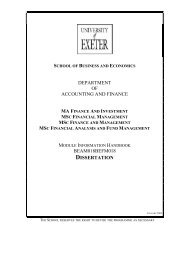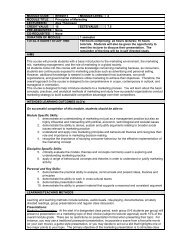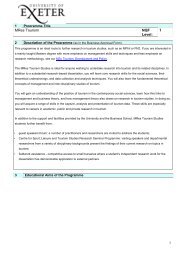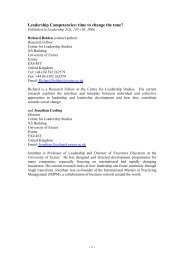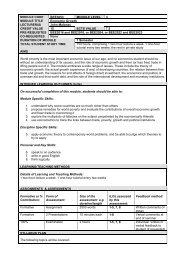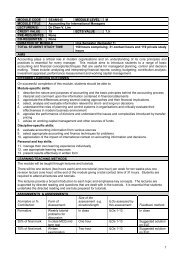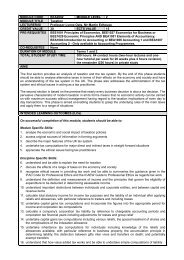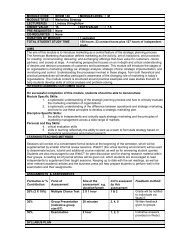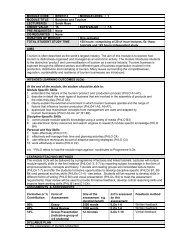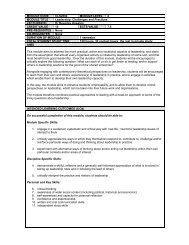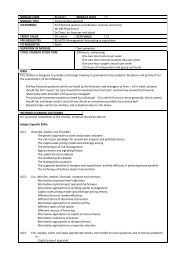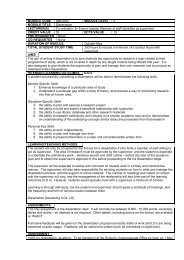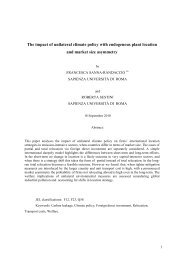MODULE CODE BEE1022 MODULE LEVEL 1 MODULE TITLE ...
MODULE CODE BEE1022 MODULE LEVEL 1 MODULE TITLE ...
MODULE CODE BEE1022 MODULE LEVEL 1 MODULE TITLE ...
Create successful ePaper yourself
Turn your PDF publications into a flip-book with our unique Google optimized e-Paper software.
<strong>MODULE</strong> <strong>CODE</strong> <strong>BEE1022</strong> <strong>MODULE</strong> <strong>LEVEL</strong> 1<br />
<strong>MODULE</strong> <strong>TITLE</strong> Introduction to Statistics<br />
LECTURER(S) Dr Carlos Cortinhas<br />
CREDIT VALUE 15 ECTS VALUE 7.5<br />
PRE-REQUISITES None<br />
CO-REQUISITES None<br />
DURATION OF <strong>MODULE</strong> 1 semester<br />
TOTAL STUDENT STUDY TIME 150 hours comprising 36 contact hours and 114 hours of<br />
independent study<br />
AIMS<br />
The module aims to provide students with an understanding of the role of statistical methodologies in<br />
economics and in the business and management environment through both theoretical input and<br />
extensive hands-on practice, using the Excel and Minitab software with a variety of data types and<br />
statistical models.<br />
INTENDED LEARNING OUTCOMES (ILOs)<br />
On successful completion of this module, students should be able to:<br />
Module Specific Skills:<br />
1. construct charts and calculate appropriate descriptive statistics to summarise a data set<br />
2. solve a range of problems involving probability<br />
3. compute and interpret the results of hypothesis testing<br />
4. fit and interpret bivariate and multivariate regression models<br />
5. demonstrate the ability to utilise a software package (Excel and Minitab) for a range of statistical<br />
applications<br />
6. compute and interpret a variety of parametric and non-parametric methods of inference<br />
Discipline Specific Skills:<br />
7. demonstrate awareness of the role of numerical evidence in the business and management<br />
environment<br />
Personal and Key Skills:<br />
8. demonstrate quantitative, computational and computer literacy skills<br />
9. demonstrate written communication skills<br />
LEARNING/TEACHING METHODS<br />
The module will be taught by lectures and tutorials. There will be two one-hour lecture and a one-hour<br />
tutorial per week (in a computer lab) plus revision lecture(s) at the end of the programme giving a total<br />
contact time of 36 hours. Students are required to attend all lectures and tutorials. A register will be taken<br />
in tutorials and attendance will be monitored in lectures.<br />
The lectures provide a broad introduction to each topic, emphasise key points and demonstrate use of the<br />
software. The lectures are supported by directed reading and questions/exercises that are dealt with in the<br />
tutorials.<br />
It is essential that students undertake the directed reading and are fully prepared for tutorials.<br />
ASSIGNMENTS & ASSESSMENTS<br />
Formative or %<br />
Contribution:<br />
Form of<br />
Assessment:<br />
Formative Weekly multi choice<br />
quizzes (online)<br />
Formative Weekly tutorial<br />
exercises<br />
90% of the<br />
final mark<br />
Size of the<br />
assessment e.g.<br />
duration/length<br />
ILOs assessed<br />
by this<br />
assessment:<br />
10-20 minutes ILOs 2,3,4,6,7,8 VLE<br />
1 hour ILOs 7,8 In class<br />
Feedback method:<br />
Examination 2 hour ILOs 1-4,6,7,8,9 Final grade; Exam<br />
Solutions will be<br />
posted on VLE<br />
10% of the Weekly multi choice 5-10 minutes ILOs 5,8 VLE
final mark quizzes on Excel<br />
and Mintab (in<br />
tutorials)<br />
SYLLABUS PLAN<br />
• An Introduction to Statistics<br />
• Descriptive Statistics: Tabular and Graphical Methods<br />
• Descriptive Statistics: Numerical Methods<br />
• Introduction to Probability<br />
• Discrete Probability Distributions<br />
• Continuous Probability Distributions<br />
• Sampling and Sampling Distributions<br />
• Interval Estimation<br />
• Hypothesis Tests<br />
• Statistical Inference about Means and Proportions with two Populations<br />
• Inference about Population Variances<br />
• Tests of Goodness of Fit and Independence<br />
• Analysis of Variance and Experimental Design<br />
• Simple Linear Regression<br />
• Multiple Regression<br />
• Regression Analysis: Model Building<br />
• Revision<br />
INDICATIVE LEARNING RESOURCES<br />
Indicative basic reading list:<br />
The main text is:<br />
• Anderson, D., Sweeney, D., Williams, T., Freeman, J. and Shoesmith, E. (2010) Statistics for<br />
Business and Economics, 2 nd edition, Andover, Hampshire: Cengage Learning.<br />
Students will also find useful the material in:<br />
• Bowerman, L., O’Connell, R., Orris, J. and E. Murphree (2008), Essentials of Business<br />
Statistics, 3 rd edition, London: McGraw-Hill.<br />
• Barrow, M. (2006) Statistics for Economics, Accounting & Business Studies, 4 th edition,<br />
London: Financial Times Prentice Hall.<br />
DATE OF LAST REVISION June 2010



